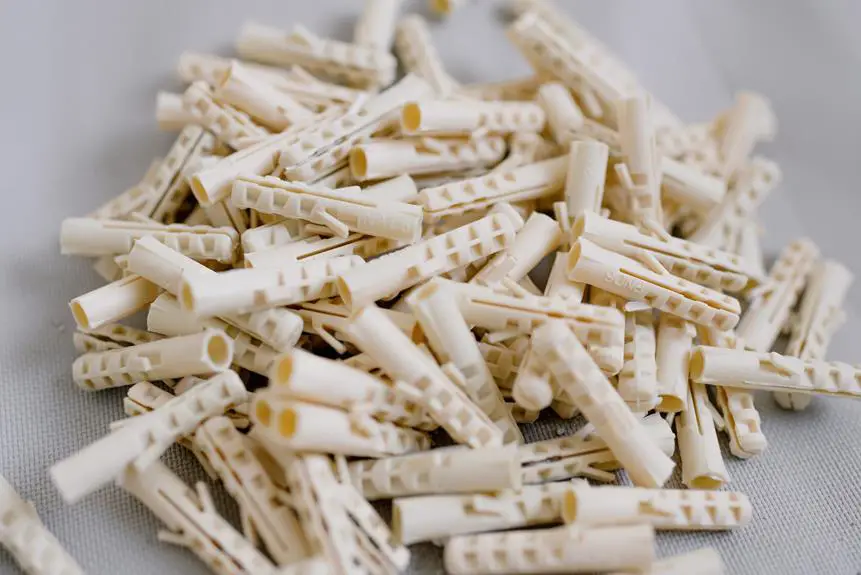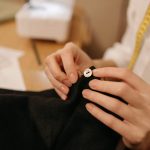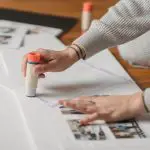So, you've managed to snag your favorite shirt again. Don't worry, there are 5 easy ways to repair fabric rips that you can master in no time.
From basic hand-sewing to using fabric glue, these techniques will have your torn garments looking as good as new.
Whether you prefer the precision of machine stitching or the art of darning and weaving, we've got you covered.
No need to panic when you discover a rip – with these simple methods, you'll be a fabric repair pro in no time.
Key Takeaways
- Hand-sewing methods require basic supplies and involve aligning torn edges, inserting a needle, and creating small, even stitches along the tear.
- Machine stitching techniques involve selecting the right needle and thread, threading the sewing machine correctly, and using backstitching to secure the thread while stitching along the rip.
- Fabric glue provides a strong bond and is suitable for various fabrics, but alternatives like sewing repair and iron-on patches also offer strong and flexible solutions.
- Iron-on patch repair involves choosing a patch that matches the garment, applying heat and pressure with an iron, and ensuring the patch is centered and securely attached over the tear.
Basic Hand-Sewing Method
You can easily repair fabric rips using a basic hand-sewing method in just a few simple steps.
First, gather the necessary supplies: a needle, thread that matches the fabric, scissors, and a thimble to protect your finger.
To start, thread the needle and tie a knot at the end of the thread. Then, carefully align the torn edges of the fabric and hold them together.
Begin stitching by inserting the needle from the backside of the fabric, pulling it through, and then pushing it back down. Repeat this process, creating small, even stitches along the tear. Remember to keep the stitches close together for a secure repair.
Once you reach the end of the rip, tie off the thread with a knot and trim any excess.
When sewing, ensure the stitches are tight enough to hold the fabric together but not too tight that they pucker the material.
Machine Stitching Technique
After mastering the basic hand-sewing method, you can also repair fabric rips using a machine stitching technique for a more efficient and durable fix. To begin, select a needle suitable for the fabric and a thread color that matches.
Before you start, ensure that your sewing machine is threaded correctly and the tension is adjusted for the fabric you're repairing. Position the fabric under the presser foot and lower the needle into the fabric at the beginning of the rip. Backstitch a few stitches to secure the thread, then continue stitching along the rip, keeping the fabric aligned with the edge of the presser foot.
Once you reach the end of the rip, backstitch again to secure the thread. Trim any excess thread and inspect the repair to ensure the fabric edges are aligned and the stitching is secure.
Practice different sewing machine techniques such as zigzag or straight stitch to find the most suitable for each type of fabric to achieve the best results. With practice, you'll master this machine stitching technique for repairing fabric rips efficiently and effectively.
Fabric Glue Repair
How effectively can fabric glue repair fabric rips? Fabric glue can be a quick and convenient solution for repairing fabric tears, especially for those who desire mastery in fabric repair. It provides a strong bond and is suitable for a variety of fabrics. However, it's important to consider fabric glue alternatives and fabric tear prevention techniques to ensure a long-lasting repair.
Here's a comparison table to help you understand the effectiveness of fabric glue repair and its alternatives:
| Aspect | Fabric Glue Repair | Sewing Repair | Iron-On Patches |
|---|---|---|---|
| Strength of Bond | Strong | Strong | Moderate |
| Ease of Application | Easy | Moderate | Easy |
| Flexibility | Varies | Flexible | Flexible |
When using fabric glue, consider the strength of the bond, ease of application, and flexibility. While fabric glue can be effective, sewing repair and iron-on patches also offer strong and flexible solutions. Additionally, focusing on fabric tear prevention techniques can reduce the need for frequent repairs, ultimately prolonging the life of your fabric items.
Iron-On Patches
Iron-on patches offer a simple and effective solution for repairing fabric rips. When dealing with a tear in your fabric, these patches provide a quick and durable fix.
To reinforce the fabric, start by choosing a patch that matches the color and texture of the garment. Lay the garment on a flat, heat-resistant surface and position the patch over the tear, ensuring it covers the damaged area completely. Then, apply heat and pressure using an iron. Follow the patch manufacturer's instructions for the appropriate heat setting and duration.
Once the patch has adhered to the fabric, allow it to cool before checking the bond. If needed, repeat the ironing process for additional reinforcement.
Patch application is crucial for a successful repair. Make sure the patch is centered over the tear and that all edges are securely attached. When ironing, apply even pressure and move the iron methodically across the patch to ensure uniform adhesion.
With the right technique, iron-on patches can seamlessly mend fabric rips, providing a durable and inconspicuous solution.
Darning and Weaving Tricks
To mend fabric rips using darning and weaving tricks, assess the extent of the damage and gather the necessary tools and materials.
When selecting a thread for darning or weaving, it's crucial to choose one that matches the fabric in both color and thickness. For a seamless repair, opt for a thread that closely resembles the original fabric. Additionally, consider the strength of the thread; a high-tensile thread is ideal for areas of high stress.
When it comes to needle size, choose one that easily fits through the weave of the fabric without causing further damage. A smaller needle is generally preferable for finer fabrics, while a larger needle may be necessary for heavier materials. Utilize a sharp needle to ensure smooth penetration of the fabric, facilitating a neat and precise repair.
Frequently Asked Questions
Can I Use a Patch From an Old Piece of Clothing to Repair a Fabric Rip?
Yes, you can use a patch from an old piece of clothing to repair a fabric rip. It's a simple and cost-effective method for fabric patching and clothing repair. Just ensure the patch is of similar fabric and secure it with careful stitching.
Is There a Specific Type of Fabric Glue That Works Best for Repairing Rips?
For repairing fabric rips, the best fabric glues to consider are those designed specifically for fabric repairs. However, if you're looking for alternative repair methods, sewing on a patch or using iron-on fabric patches can also be effective.
Can I Use a Sewing Machine to Repair Delicate or Thin Fabrics?
Yes, you can use a sewing machine to repair delicate fabrics. It's a great option for old clothing, knitted fabric, and leather. Using a fabric patch and the best type of fabric glue are effective repair methods.
What Is the Best Technique for Repairing a Rip in a Knitted or Crocheted Fabric?
To repair a rip in knitted or crocheted fabric, the best technique is using the darning technique for invisible mending. Another effective method is needle felting, which allows for sturdy embroidery repair.
Can I Repair a Rip in a Leather or Suede Fabric Using These Methods?
You can repair a rip in leather or suede fabric using specific methods. Leather repair involves using a repair kit or sewing with a leather needle and thread. Suede restoration requires gentle brushing and patching with a suede repair kit.
- What Is Needle-Punched Nonwoven Fabric? (E.G., Felt) - July 11, 2025
- Understanding Thermal Bonding in Nonwoven Fabric Manufacturing - July 11, 2025
- Can Nonwoven Fabric Be Used for Upholstery? - July 11, 2025






